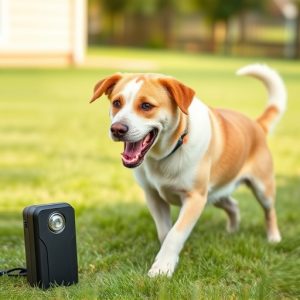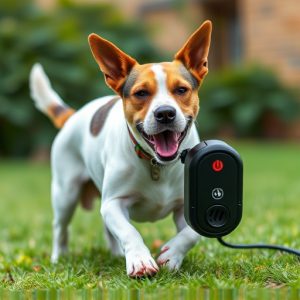Safe Ultrasonic Frequencies: Controlling Dog Behavior with Science
Sound waves hold immense potential in shaping canine behavior through safe ultrasonic frequencies (2…….
Sound waves hold immense potential in shaping canine behavior through safe ultrasonic frequencies (22-50 kHz) for dog control. These inaudible to humans tones manipulate dogs' actions by targeting their sensitive ear structures, inducing natural aversion responses and encouraging desired behaviors through positive reinforcement training. This innovative and humane approach offers a crucial alternative to traditional punishment techniques, prioritizing the well-being of pets while achieving effective training outcomes.
“Unleash the power of sound waves to harness and guide canine behavior with our comprehensive guide. This article delves into the intriguing world of pet behavior control using ultrasonic frequencies, offering a novel approach to training. We explore the science behind this method, understanding how specific sound waves can subtly influence dog behavior while ensuring their safety. By examining the choice of frequencies and implementation strategies, you’ll gain insights into employing safe ultrasonic frequencies for effective dog control.”
- Understanding Sound Waves and Dog Behavior
- The Science Behind Ultrasonic Frequencies for Canine Control
- Ensuring Safety: Choosing the Right Frequencies and Implementation Strategies
Understanding Sound Waves and Dog Behavior
Sound waves are a powerful tool that can influence and control animal behavior, particularly in dogs. By understanding how sound waves interact with living beings, we can harness their potential to create effective yet safe training methods. Dogs, being highly sensitive creatures, respond to sounds differently based on their frequencies. Safe ultrasonic frequencies for dog control fall within a range that is inaudible to humans but perceptible to canine ears. These high-frequency sound waves can be used as a non-physical reinforcement to modify behavior.
When dogs hear these specific ultrasonic tones, they often exhibit signs of distress or avoidance, which can be interpreted as negative reinforcement. This method takes advantage of their natural instincts and sensitivity to certain sounds without causing any harm. By strategically using safe ultrasonic frequencies at the right moments during training sessions, dog owners and trainers can encourage desired behaviors while discouraging unwanted actions, making it a promising alternative to traditional, potentially stressful training methods.
The Science Behind Ultrasonic Frequencies for Canine Control
The Science Behind Ultrasonic Frequencies for Canine Control
Ultrasonic frequencies, those high-pitched sounds beyond human hearing range, have emerged as a innovative tool in canine behavior modification. Devices employing safe ultrasonic frequencies for dog control emit sound waves that are unpleasant to dogs, disrupting their attention and concentration without causing harm. This non-invasive approach leverages the canine ear’s sensitivity to certain frequencies, which can be fine-tuned to create an effective yet humane deterrent.
Research has shown that specific ultrasonic tones can trigger a natural aversion response in dogs, prompting them to avoid certain areas or behaviors. Unlike traditional punishment methods, safe ultrasonic frequencies for dog control focus on redirection and reinforcement of positive behavior. By combining these sounds with rewards or positive reinforcement training, owners can teach their pets desirable alternatives, ultimately shaping their behavior without resorting to unpleasant or stressful experiences.
Ensuring Safety: Choosing the Right Frequencies and Implementation Strategies
When considering sound wave pet behavior control, particularly for dogs, ensuring safety is paramount. The key to safe ultrasonic frequencies lies in selecting the right range and implementation strategies. Studies have shown that ultrasonic sounds ranging from 22-50 kHz are generally effective in modifying canine behavior without causing harm. These frequencies are inaudible to humans, making them humane alternatives to traditional training methods.
Implementing these sound wave technologies requires careful consideration of placement, timing, and duration. Strategically positioning ultrasonic emitters in problem areas, such as near doors or windows where dogs tend to bark excessively, can be effective. Additionally, using the sounds at opportune moments when problematic behavior occurs, combined with positive reinforcement training, can reinforce desired behaviors. Regular adjustment and monitoring of frequency levels and emission patterns are essential to maintain safety and effectiveness.
Sound wave pet behavior control, leveraging safe ultrasonic frequencies, offers a innovative and non-lethal approach to managing canine conduct. By understanding dog behavior and the science behind specific ultrasonic ranges, we can create environments that are both harmonious and well-behaved. Implementing these strategies with care ensures safety while promoting positive reinforcement, paving the way for a more peaceful coexistence between pets and their owners. Remember, when used responsibly, safe ultrasonic frequencies can be a game-changer in navigating the intricate tapestry of pet behavior.


